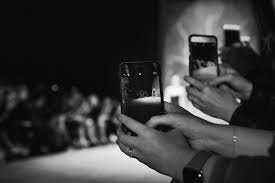Fashion Forward: Exploring the Impact of Design in Smartphone Trends
Introduction
In an era where style meets functionality, smartphones have become more than just communication devices—they are fashion statements. The convergence of design and technology has given rise to a new realm of mobile fashion, where aesthetics and trends play a pivotal role in shaping consumer preferences. From sleek minimalist designs to bold statement pieces, this article delves into the captivating world of Mobile Fashion: The Influence of Design in Smartphone Trends, uncovering the symbiotic relationship between fashion and technology.
Design Trends: From Minimalism to Maximalism
Design trends in the mobile industry mirror those of the fashion world, oscillating between minimalist sophistication and bold maximalist expressions. Sleek, minimalist smartphones with clean lines and understated elegance appeal to those seeking a timeless aesthetic, while vibrant, eye-catching designs cater to individuals looking to make a statement. From monochrome finishes to iridescent gradients, design choices reflect individual preferences and cultural influences, shaping the landscape of mobile fashion.
Material Innovation: Blending Style and Substance
Materials play a crucial role in defining the look and feel of smartphones, with innovative materials transforming devices into fashion-forward accessories. From luxurious glass finishes to sustainable alternatives like bamboo and recycled plastics, material choices reflect a commitment to both style and sustainability. As consumers become increasingly conscious of the environmental impact of their purchases, mobile fashion embraces eco-friendly materials and ethical manufacturing practices, catering to a growing demand for sustainable luxury.
Collaboration Culture: Fashion Meets Technology
Collaborations between fashion houses and technology companies have become increasingly prevalent, blurring the lines between fashion and tech. From designer smartphone collections to limited-edition collaborations, these partnerships fuse cutting-edge technology with high fashion, creating products that appeal to discerning consumers. By leveraging the cachet of fashion brands and the innovation of tech giants, these collaborations redefine the concept of luxury in the mobile industry, elevating smartphones to coveted fashion accessories.
Personalization Paradigm: Customization and Individuality
Personalization has emerged as a dominant trend in mobile fashion, with consumers seeking devices that reflect their unique personalities and lifestyles. Customization options, such as interchangeable covers, engraved designs, and bespoke finishes, allow individuals to tailor their smartphones to their preferences, fostering a sense of ownership and individuality. As consumers increasingly prioritize self-expression and authenticity, personalized mobile fashion offerings cater to a desire for uniqueness in an increasingly homogenized market.
Influencer Impact: Shaping Consumer Trends
Influencers play a significant role in shaping consumer trends in the realm of mobile fashion, with their endorsements driving product preferences and purchase decisions. From unboxing videos to sponsored content, influencers showcase the latest smartphone designs and features, influencing consumer perceptions and fostering brand loyalty. By leveraging the power of social media and influencer marketing, mobile companies amplify their reach and engagement, positioning their products as must-have accessories in the world of fashion and technology.
FAQs
How does design influence consumer perceptions of smartphones?
Design plays a crucial role in shaping consumer perceptions of smartphones, influencing factors such as aesthetics, usability, and brand image. Sleek, minimalist designs evoke notions of sophistication and premium quality, while bold, expressive designs appeal to those seeking individuality and self-expression. Ultimately, design choices reflect consumer preferences and cultural influences, shaping the perceived value of smartphones in the eyes of consumers.
What are some emerging trends in mobile fashion?
Emerging trends in mobile fashion include sustainable materials, minimalist designs, and personalized customization options. Eco-friendly materials such as bamboo and recycled plastics are gaining popularity due to growing consumer awareness of environmental issues. Additionally, minimalist designs with clean lines and understated elegance cater to individuals seeking timeless sophistication, while personalized customization options allow for greater self-expression and individuality.
How do collaborations between fashion houses and technology companies impact the mobile industry?
Collaborations between fashion houses and technology companies drive innovation and creativity in the mobile industry, merging the worlds of fashion and technology to create unique products that resonate with consumers. These partnerships leverage the design expertise of fashion brands and the technological prowess of tech companies, resulting in products that appeal to fashion-forward consumers seeking both style and functionality.
Why is personalization important in mobile fashion?
Personalization is important in mobile fashion because it allows consumers to express their individuality and tailor their devices to their preferences. Customization options such as interchangeable covers, engraved designs, and bespoke finishes empower consumers to create unique smartphones that reflect their personalities and lifestyles, fostering a deeper connection between consumers and their devices.
How do influencers influence consumer trends in mobile fashion?
Influencers wield significant influence in shaping consumer trends in mobile fashion through their social media presence and content creation. By showcasing the latest smartphone designs and features in unboxing videos, sponsored posts, and product reviews, influencers drive consumer awareness and interest, influencing purchasing decisions and brand perceptions.
What role does sustainability play in mobile fashion?
Sustainability plays a growing role in mobile fashion, with consumers increasingly prioritizing eco-friendly materials and ethical manufacturing practices. Sustainable materials such as recycled plastics and bamboo offer alternatives to traditional materials, reducing the environmental impact of smartphone production. Additionally, initiatives such as recycling programs and eco-label certifications promote environmental stewardship and transparency in the mobile industry.
Conclusion
In conclusion, Mobile Fashion: The Influence of Design in Smartphone Trends embodies the fusion of style and technology, shaping consumer preferences and redefining the concept of luxury in the mobile industry. From minimalist elegance to bold statement pieces, design choices reflect individual tastes and cultural influences, transforming smartphones into fashion accessories. As the intersection of fashion and technology continues to evolve, mobile fashion remains at the forefront of innovation, captivating consumers with its blend of style, functionality, and individuality.
